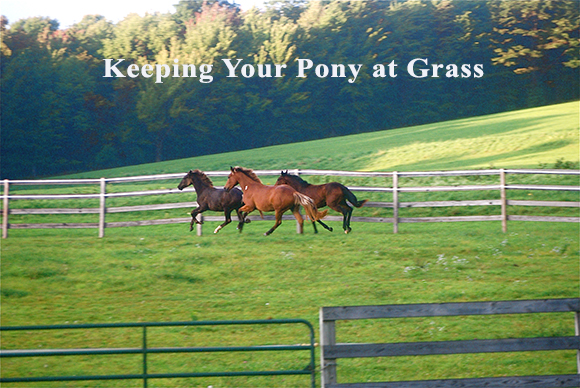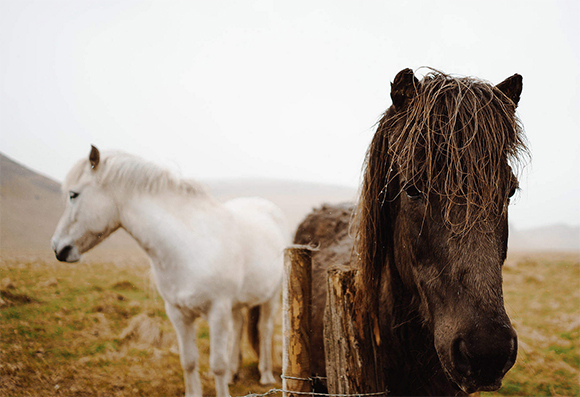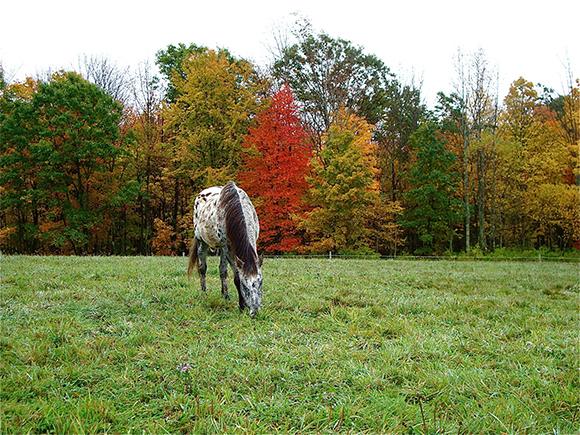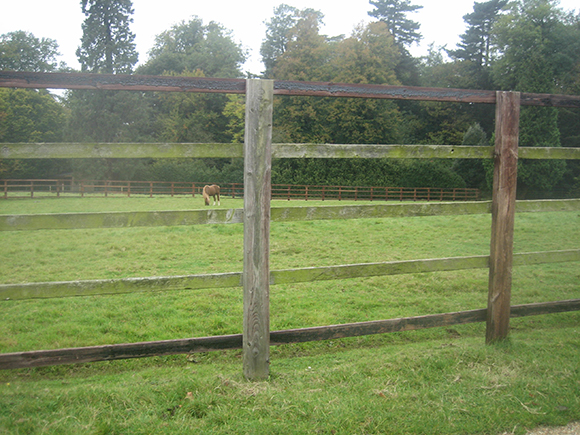Keeping Your Pony at Grass

You might think that keeping your pony at grass takes less management and thought than keeping him in a stable but you would be wrong. Your pony relies on you to make smart decisions to keep him happy and safe. All ponies are not created equal and some may need extra special care to be happy living outside.
There are great advantages for keeping your pony in a near natural environment. He can move freely and keep his joints lubricated and he can munch to his heart’s content keeping his digestive tract full and free of ulcers. There are disadvantages too however. He may not have as refined a coat, he may not be readily available for riding if he is wet or muddy and he may lose some condition. Let’s take a look at the factors that affect his well-being.
The age of your pony does not really matter, unless your pony is ancient in which case he may need blanketing and more food. Even newly born foals can do fine outside and their mothers will protect them from predators. Extreme cold and extreme heat are both hazards to the very young and very old, so bear this in mind.
The breed of your pony is also important. Most ponies hail from hearty breed lines that came of age roaming hill and dale in all weathers. Finely bred ponies however may need a little extra help in extreme weather to be kept comfortable with blankets in winter and fly protection in summer. You must consider your pony as an individual with his own needs. His temperament is another factor to consider. If your pony is a content sort, then having freedom outside to march around as he pleases will be fine but a more highly-strung pony may become needy and upset pacing the fence line and not thrive which will result in weight loss, worn feet and general unhappiness.

A pony that has led a busy competitive life may take a while to adjust to the slower pace of outdoor living, so it is best to introduce them to full turnout gradually by adding a few hours each day until they can happily go out for twenty-four hours.
When considering the temperament of your pony it is also important to understand how well he plays with other ponies. Just because your pony is a sweetheart with you in the barn does not mean he will be good at playing with other ponies in the paddock. It is important to be watchful at turnout and be ready to step in and separate ponies if they do not establish their pecking order without becoming overly aggressive. It is best to start by turning ponies out in a pair, and gradually adding others to the group. Do not start by adding your lovely pony to a herd of twenty others and leave him to fend for himself. Start by turning him out with a herd member you believe is slightly above middle in the packing order of group. This will give you an idea of where he will ultimately fit in.
Gender is also important. Obviously you won’t be turning a stallion out with mares unless there is a plan to breed. Turning out mares with mares and geldings with geldings are generally recommended. During summer months when mares are in season the pecking order may change and arguments may ensue especially during late summer when the mare’s estrous cycle is strongest, so pay special attention to herd dynamics at this time of year.
Also be aware your horse may become herd bound if he is left out with the herd for long periods of time and not wish to come in and work when you wish to ride. This is especially true if just two horses are turned out together. It is always prudent to bring in the second pony while you ride, to ensure he does not become overly upset and run and damage himself trying to escape the confines of the paddock and join up with his buddy.
As ponies will argue from time to time it is also a good idea to pull hind shoes for herd turnout for extra safety.
Ponies are notoriously more prone to laminitis than horses due to their size, and it generally occurs as a result of introducing them too fast to too much fresh grass. This is another reason to extend the time on the pasture gradually and allow your pony time to acclimate to fresh grass. Many people wrongly believe that Spring grass is the most dangerous as far as contracting laminitis is concerned. In fact it is in the Fall, when the grass is probably at its shortest after the summer months when the sugar content is the highest and that the risk for this disease is more prevalent. It is prudent to muzzle ponies if you feel they are becoming too overweight or simply eating to much grass or if they have had a previous history of laminitis. Muzzles can rub and cause sores so be certain that the one you select is well fitted and kept clean.

If you have determined that your pony will enjoy time away at grass then the next step is to take a close look at the pasture. The pasture may be new to horses or it may be completely overgrazed by horses or other livestock already. A pasture should always be checked for poisonous plants and be aware that cows, sheep and goats may do fine on a pasture that can still pose a threat to your pony as equines have a different tolerance than other animals to certain plants. If you need advice on what constitutes a toxic plant and what doesn’t consult your local County Extension Officer who will be happy to walk the fields with you and advise on possible dangers. Don’t overlook dangerous trees in this evaluation. Certain trees may be hazardous during Fall when they drop their seeds. Others may exude toxic substances on leaves, or if horses over ingest leaves of certain trees they can do liver damage.
Inspect the pasture closely for any mechanical hazards that may lurk in the long grass. Old farm equipment, harrows, metal or foreign objects, plastic, garbage, large rocks or stones must all be removed before turn out.
The fencing must also be carefully inspected. Barbed wire fences and equines do not mix and a serious hazard. Fences may be electric, board fenced or made of a myriad of modern materials. If boarded the bottom board should be installed a minimum of nine inches from the ground to prevent your pony catching his leg underneath and not being able to disentangle himself. The height of the fence will hopefully be a minimum of four feet, but use your common sense. Obviously a smaller pony can manage with a lower fence than a taller one. Unless of course he likes to jump out of paddocks!
If the field has square corners it is a good idea to add a diagonal rail across the corner to prevent ponies from being cornered by a colleague and hurt. Rounded corners are much safer than squared off corners.
Don’t overlook the gate and the hardware that secures it safely. Your pony and his companions will likely spend some time idling at the gate and they are well aware this is the way out of the paddock so be sure it is secure.
Ponies can lift gates off hinges so it is always a good idea to reverse the top hinge on a gate if possible so the gate cannot be lifted off. It is also beneficial to have a gravel area throughout the gate area to avoid mud.
It is important that there is some sort of turnout shelter in the field for extreme weather. Ponies will generally use the shelter more in the sweltering heat of summer than the freezing rain of winter and it should be kept clean to minimize fly populations and if possible have some sort of stone-dust or similar material base so it does not become muddy through Spring and Fall use.
With turnout shelters it is important they are large enough to accommodate the pony population in that particular pasture. Narrow doors or doors of any sort are a recipe for disaster as ponies may argue and hit their hips dashing in and out. It is best if there is no center pole for the same reason.
An added bonus is to have lighting for the gate area for winter evening feedings and to allow you to do your visual check on the well-being of the ponies.
Feeding practices for turned out ponies are also important. Water is the most important resource for any equine and the water tank should be kept clean and well filled at all times. In freezing temperatures water heaters may be employed but be certain all electrical leads are well insulated and are out of reach of any nosy pony and that if a tank heater is used it should be covered and protected from the reach of the ponies. Water tanks are also gathering places for the herd so the tank(s) should be placed on gravel with a gradual incline toward them so that any spilled water drains away.
Also make sure any water tank cannot be knocked over by securing it if necessary to the fence or encasing it with wood.

It is common to think that a large pond in the field can be a great water source for equines but be aware that this is not necessarily true. In winter ponds may freeze and thirsty ponies may adventure on to thin ice and drown. The water may not be of good quality for the ponies to drink and any dead rodents/vermin or other creatures that may venture into it may contaminate it. It can also be contaminated by chemical run-off from neighboring fields if they are commercially farmed. Any unsuitable water supply should be fenced off from equines.
Your pony will need feeding hay to supplement the pasture during winter months and distribution of hay amongst the herd is very important to ensure that a few ponies don’t overwhelm others and bully them off their share of the food supply. Be careful if using metal round feeders designed for cattle as ponies may trap their legs in the sides. Feeding hay of the floor will be the most wasteful but it is also very safe. For every pony in the field you should throw hay in a separate pile then add one extra pile so that no pony can be chased off all food supplies. It is prudent to spread the piles out to minimize stress and bullying.
If graining your pony at pasture it is important that all ponies are fed at the same time. Fence feeders work well as they can be washed and stored between feedings. If your pony has special feed requirements then he should be brought in and fed separately.
Try not to enter the field to feed your equine. The excitement may cause ponies to kick or push and you do not want to be trampled.
The health of your pony will depend on your management of the pasture and rotating ponies across different paddocks or fields is an important strategy to prevent overgrazing and high worm population becoming prevalent on a pasture. All ponies should be wormed at the same time to prevent contamination of the pasture with worms and the manure should either be picked up, especially in smaller enclosures. It can also be harrowed in Spring and Fall, before the last frost and after the first frost when the field is rested from grazing. This will expose any worm population to the frost and kill worm populations.
Overgrazed pastures will exhibit a weed population as weeds grow faster when there is no grass, so check the pasture regularly for noxious weeds and dig them up and remove them if possible or remove the ponies from the pasture and use a natural weed-killer if available. Remember ponies are fairly sensible and won’t touch a noxious weed if there is plenty of grass to eat. However weeds that are abundant on poor pasture may be enticing during late summer. Weeds that are dead are often more hazardous than when alive.
There are various health issues that you may encounter with a pony at grass. Fly related issues such as warbles and bots. Other skin issues and diseases may arise with lice, ringworm, and ticks. Skin irritation from bugs and plants are common. Your pony may suffer sweet itch, urticaria (hives) or sunburn. Muddy manure areas in which ponies may lay down may cause hives. In cold weather you may see rain rot, cracked heels or mud fever. The feet may suffer hoof cracks, punctured soles, thrush and the pony may be bitten or kicked by a pasture mate and become injured.
For all of these reasons it is imperative that you check on your pony at least once a day preferably more frequently to check on his health. Do not forget to check all fence lines and gate latches during your visits.
If you pony is pastured in a remote pasture you may want to consider microchipping to minimize the risk of his becoming lost if he escapes or of recovering him if he is stolen.


